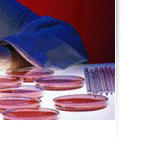Click here to go back.
ANIMAL RESEARCH DISASTER: The 'Elephant Man' Drug Victims
On March 13, 2006, eight healthy men arrived at a research facility in London, England, to participate in the first clinical trial for a drug called “TGN1412.” Two were given placebos. Six were given the drug.
An hour and a half after the drug was administered, adverse reactions began to tear through their bodies:
“...all six volunteers had a systemic inflammatory response...accompanied by headache, myalgias, nausea, diarrhea, erythema, vasodilatation, and hypo-tension.
“Within 12 to 16 hours after infusion, they became critically ill, with pulmonary infiltrates and lung injury, renal failure...” The New England Journal of Medicine Sep. 7, 2006
The Human Victims of the Experiment
“Elephant Man drug victims told to expect early death”
“VICTIMS of the disastrous “Elephant Man” drugs trial have been told they face contracting cancer and other fatal diseases as a result of being poisoned in the bungled tests.”
“Nav Modi, 24, whose bloated face and swollen chest led to the nickname “Elephant Man”, said he did not know how long he would live.” The Sunday Times July 30, 2006
“Ryan Wilson, 20, from London was the most seriously ill of the six men whose heads and bodies swelled up following injections of TGN1412 in March.
“Mr Wilson had to have fingertips and all of his toes amputated and it is not clear what his future health will hold.” BBC News Dec. 7, 2006
The Animal Experiments
TGN1412 was thoroughly experimented on animals and it tested safe for humans. The Medicines and Healthcare products Regulatory Agency (MHRA) conducted an investigation into the drug testing:
“This includes tests on animals undertaken to support the proposal that the drug can be tested in humans. All company records and processes were examined to establish whether all relevant studies had been completed correctly and proper data included in the Clinical Trials Application as required by legislation – in particular whether there was evidence of undisclosed studies. No deficiencies were found.” INVESTIGATIONS INTO ADVERSE INCIDENTS DURING CLINICAL TRIALS OF TGN1412. (MHRA)
“TeGenero, the company which has developed the drug, said the reactions in the men were completely unexpected, given earlier findings from animal and laboratory work.” BBC News March 16, 2006
“He said TGN1412 had been tested extensively in laboratories and on rabbits and monkeys, with no adverse effects and no drug-related deaths.” BBC News March 17, 2006
“It would indicate that this product showed a pharmacological effect in man which was not seen in pre-clinical tests in animals at much higher doses.” BBC news Dec. 7, 2006
“The men received doses 500 times smaller than those used in animals...”
“ The unexpected reaction of the drug - especially the cytokine storm and crash in white blood cells - took everyone by surprise. "Given the preclinical information, it was the opposite of what we expected...” New Scientist Aug. 14, 2006
Nonhuman Primates are Still Nonhuman
According to the MHRA report, the drug was tested using a “4 week intravenous toxicity study in cynomolgus monkeys with a 6 week observation period”.
The National Institutes for Health states on their website that “Nonhuman primates, in particular, are important for translational research because of their close physiological similarities to humans.”
Close, but so far as well. That drugs can destroy human health, yet pass safely on animals whose biology is so similar to ours, demonstrates the inherent flaw in using animals for research.
The true choice - the one that will lead to new discoveries and save lives - is the decision to leave animal research in the past and move to a future where drugs to be used on humans are tested on human cells and human tissue.







